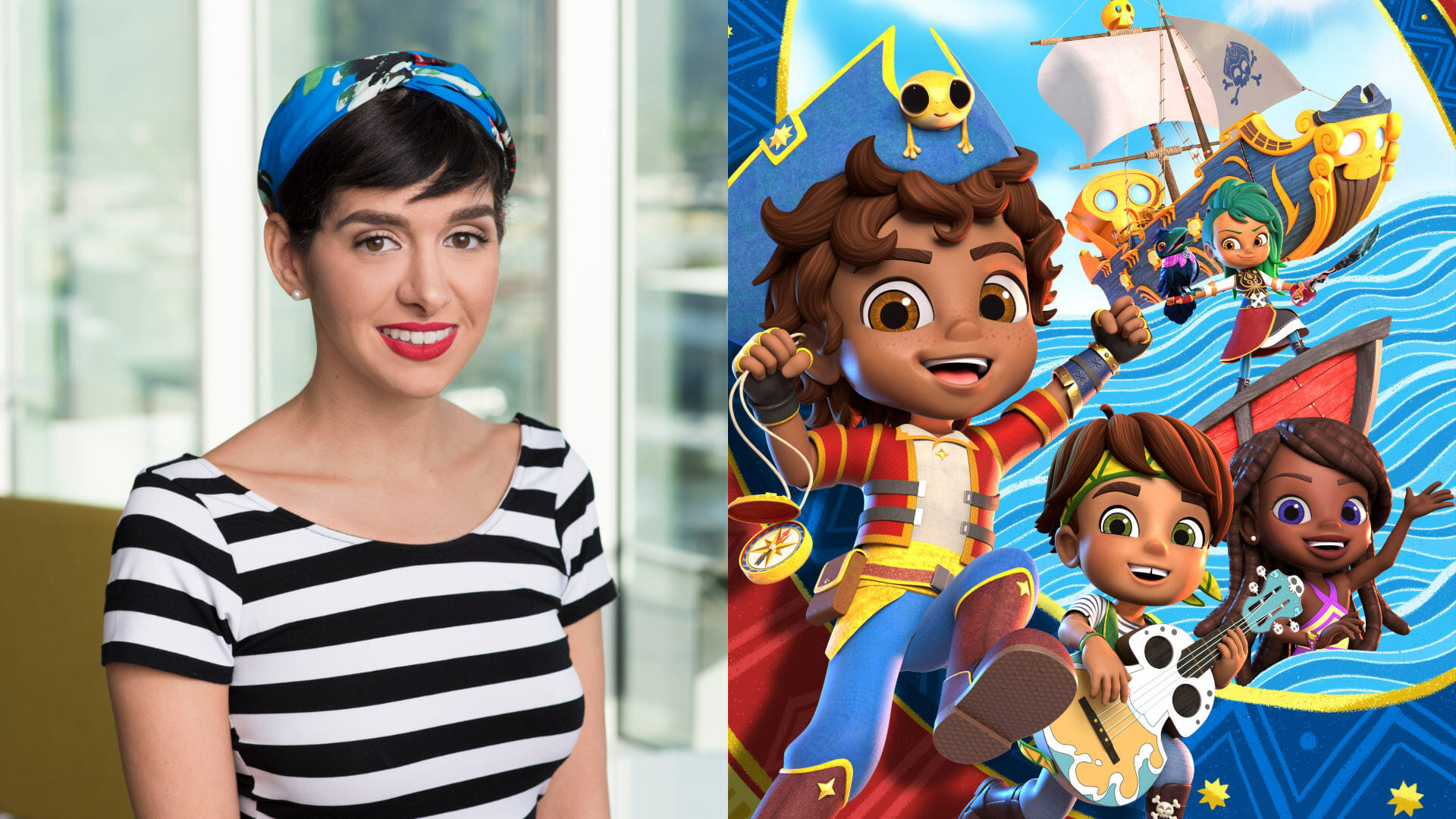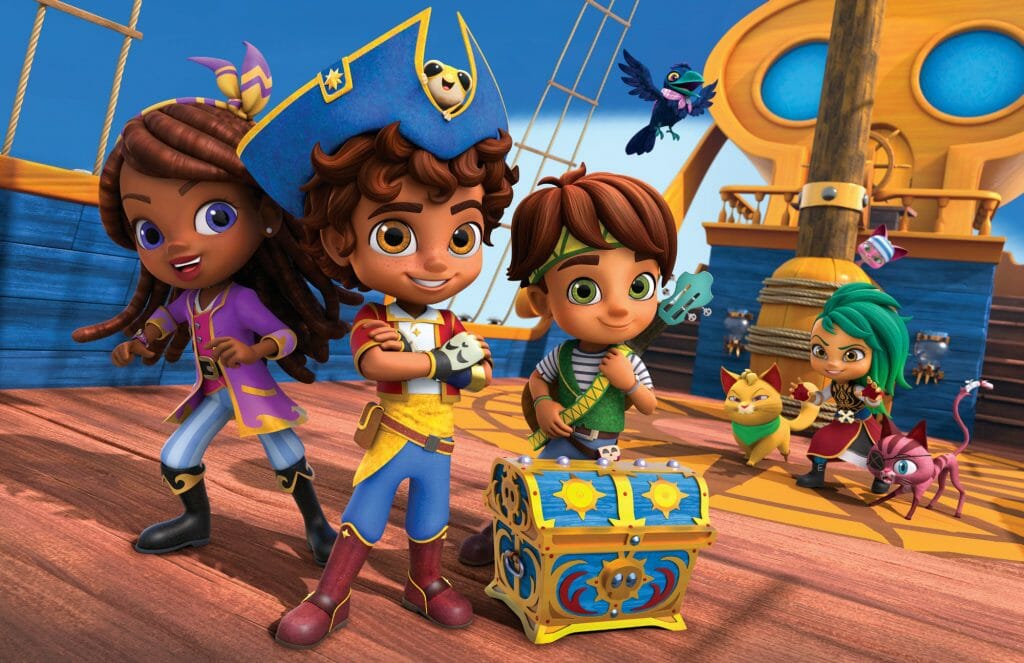
Conversations around representation in media have brought marginalized communities into the mainstream, with broadcasters and streamers publicly touting their respective diversity and inclusivity initiatives. While children’s entertainment is still experiencing growing pains, Nickelodeon’s Santiago of the Seas is charting a new course in preschool content.
Santiago of the Seas is created and co-executive produced by Niki López (Fairly Odd Parents, Glitch Techs), a Puerto Rican-born artist. Premiered in October 2020, it follows the eponymous 8-year-old, kind-hearted pirate Santiago “Santi” Montes and his best mates as they go on adventures, search for treasure and keep their home safe from villains like the nefarious Bonnie Bones. For López, it embodies an ongoing journey towards representing her language and culture, while teaching a new generation the power of kindness and empathy.
The series sailed onto screens at a pivotal time, with children consuming more media than ever due to the COVID-19 pandemic. In fact, one ParentsTogether study found that 48% of parents report their children are spending six hours per day online — a 500% increase from pre-pandemic levels. Prior to this, kids up to 8 years old averaged an hour and 40 minutes a day, while research by Nielson puts that number closer to 3.9 hours per day among 2 to 11 year olds.
If children are at home watching more content, it should positively reflect what their families look and sound like. Unfortunately, American animated cartoons remain largely white. One sample of 1,500 characters found that 11.6 percent were of Asian heritage, 5.6 percent were black and 1.4 percent were Latino.
A lack of representation in media can lead to negative psychological outcomes for those with identities that are not shown or are depicted negatively, according to Jordan Levinson, writing for UCLA’s Psychology in Action. For children, this may make them feel invisible or unimportant — leading to poor self-esteem and other serious effects. By contrast, popular characters who share their identities can lead to higher self-esteem.
Setting sail
Beneath the altruistic characters and action-packed adventures, the true treasure of Santiago of the Seas is how the animated series pays homage to López’s heritage through infusions of spoken Spanish and Latino-Caribbean culture. She has described the show as a “love letter to Puerto Rico and an ode to the magical power of empathy within an inclusive community.”
López tells us, “The idea for Santiago of the Seas really originated out of homesickness for my community — the food, the music, the environment. I was having an informational with Mary Harrington, who I call the fairy godmother of Nickelodeon, and she asked me what was important to me when I was little and I told her about my childhood and some of the mythology and history within Puerto Rico. When I started to talk about a Robin Hood of the high seas she was like, ‘Ooo, I feel like there’s something there. You should chase that.’”
So, she did just that. López took a sabbatical and went back to Puerto Rico on a treasure hunt of inspiration. While there, she visited two caves where this legendary pirate used to hide his booty — all the while imagining what her show’s animated world would look like and how it could translate to a young audience, both visually and linguistically.
“I put myself in that mindset of what this world could be and how it could work in a preschool setting, while elevating the representation of Latino-Caribbean communities as well as highlighting the importance of bilingualism and how crucial it is to champion these moral values of empathy and kindness. It was just a big old melting pot that I put all the things that mattered to me and it exploded into the Santiago of the Seas pitch,” says López.
A brief stint in the advertising world helped López refine her pitching skills, ultimately getting the show greenlit. As a Latina series creator, López herself represents how the tide is changing — part of a rising cohort of diverse faces in the animation industry. She had been hired by a woman of colour to work on her first production at Nickelodeon, who saw the value in having different perspectives.
“I’ve been very lucky to be surrounded by allies at Nickelodeon who are always looking to find ways to elevate my voice and truly honour my vision, and I hope I can do the same to those within the crew and outside even outside the studio. If there’s any way that I can give people advice or mentor them, my doors are always open,” says López.

A sea change
Describing her role as “the keeper of the lore,” writers now pitch their ideas to López and she advises whether they work in the world of Santiago of the Seas. Sometimes they are too dark for the demographic, but the process is always collaboration. López readily admits that stepping into this leadership has come with its challenges, however working closely with her talented, kind crew on fulfilling her vision has been a humbling experience.
She explains, “I think it’s been cool to let go a bit and be pleasantly surprised as to how elevated the show has become by trusting my crew. I definitely went through the rite of passage of, ‘Am I doing this right? Am I a good leader?’ The impostor syndrome played its tricks on my head every so often, but time conditions you to the experience and I’ve been lucky to have certain people in my crew who have been extremely supportive, as well as Eryk Casemiro (Senior Vice President, Nickelodeon Preschool) and Ramsey Naito (President, Nickelodeon Animation).”
Support from both López’s crew and studio executives have meant clear sailing for Santiago of the Seas. Across both ratings and reactions from audiences, the positive results have spoken for themselves — in both English and Spanish. For López, this bilingual inclusivity was both paramount and personal.

“We have research and real time instances of how little kids are immediately affected by the show — kids that might come from Spanish-speaking households and they’ve been hesitant to speak their language. They are seeing a hero that looks like them and represents their community and is speaking in Spanish, so they feel confident to embrace their culture and language. Having that effect is so cool; you’re giving them the confidence they need to realize it’s okay to be you and to be proud of where you come from,” says López.
She continues, “There’s no need to hide any of that and I wish I would have seen more of that when I was young because I remember watching American television productions and I never saw a character that reflected me or where I came from or was empowering in the way of them speaking Spanish. I was like, ‘Oh, okay. Well, maybe English is the way to go.’ I’m trying to pay it forward and change the game so little kids don’t have to go through that journey of self-doubt like I experienced about speaking my language and embracing my culture.”
Having recently received a second season order, López’s bilingual, multicultural message has clearly resonated. Looking ahead, she hopes to explore the Santiago of the Seas universe further through a film or even a spin-off series for Bonnie. While those possibilities have yet to be discovered, more empathetic children can now be found across the world — no pirate’s map required.



